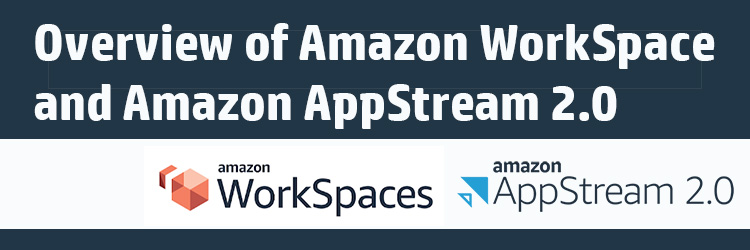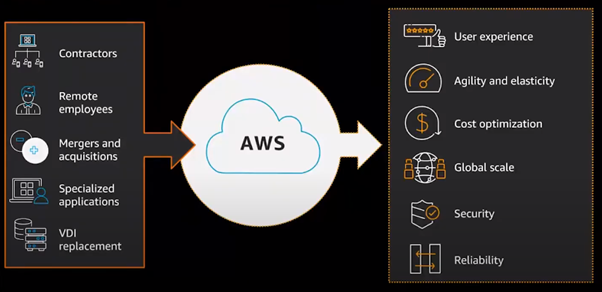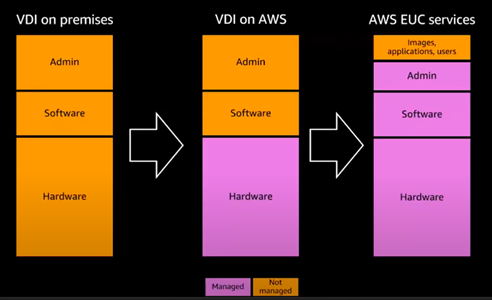
AWS now hosts solutions for millions of customers. Customers who have moved from on-premise data centers to AWS include some of the fastest-growing start-ups, the largest enterprises, and leading government agencies. They did so for the following reasons.
Agility and Elasticity: The elasticity and agility provided by AWS over on-premise infrastructure are unparalleled. Most organizations will take a long time to obtain on-premise infrastructures such as servers. Then, to build all software components, such as computing and storage, databases, analytics, and machine learning. In the Cloud, you can provision thousands of servers in minutes, enabling a much faster implementation
Cost optimization: Traditional infrastructure requires decisions such as: Do I provision on the low side and worry about outages? Or should I design for peak capacity, which may go unused? But, you only provision what you need in the Cloud. If it turns out that you don't need it, you stop paying for it.
Global scale: AWS operates on a global scale. Many organizations have a global presence and must meet country-specific data sovereignty requirements.
Security: Customers inherit all of the best practices of AWS policies, architecture, and operational processes designed to meet the needs of the most security-conscious customers.
Reliability: AWS builds data centers in multiple geographic regions and availability zones. Each region provides the highest level of resilience against system disruptions. Also, AWS designs its data centers with significant access bandwidth connections. If there is a major outage, there is sufficient capacity to allow traffic to be load balanced to the remaining sites.
Because of the globalization of the economy, it is now possible to work from anywhere, with anyone, at any time. Today's workforces are becoming more mobile. Organizations want employees to be able to work securely from any location. In fact, contractors now hold one out of every five jobs. 79% of organizations anticipate an increase in merger and acquisition activity, and 70% of employees work remotely. As a result, security becomes increasingly challenging, and organizations are attempting to manage the constantly changing user base. Organizations want to follow users without compromising security, especially since one in every three data breaches today results from lost or stolen devices. Customers have stated that changing the data center, changing the workforce, and increasing security challenges are driving them to migrate end-user computing to the Cloud. In fact, half of all IT decision-makers are shifting their end-user computing to solutions such as Desktop-as-a-Service (DaaS) or Virtual Desktop Infrastructure (VDI).
Why do customers choose AWS?
Organizations are increasingly looking for ways to enable employees to work securely from anywhere. Organizations want dependable remote work solutions to ensure business continuity in the face of disasters. Customers are choosing AWS to reap the core AWS benefits that on-premise solutions do not provide. By co-locating user desktops, applications, and data in the Cloud, a better user experience can be provided. But it goes much further than that. It improves agility by allowing for the onboarding and offboarding of contractors and users worldwide.
Furthermore, it reduces costs by shifting from large capital expenditures for VDI servers or physical PCs to a pay-as-you-go pricing model. Organizations enable remote employees by developing their solutions in AWS regions worldwide. Security and reliability improve by moving corporate data from on-premise VDI servers and user devices to AWS.

How do the above benefits empower End User Computing (EUC)?
User experience: Many customers believe AWS offers a better user experience. Because your desktops, applications, and files are stored alongside your data on AWS, you can securely allow users to work from anywhere in the world while providing a highly responsive experience.
Agility and elasticity: Customers report that on-premise VDI or physical PCs make it hard to achieve agility and elasticity. When contractors or new employees begin work due to a merger and acquisition, they require access to their desktops, applications, files, and content as soon as possible. However, it can take months to onboard new users. It takes time to buy, image, ship, and support devices and to build multiple data centers for traditional VDI deployments. With AWS, there is no hardware to purchase, deploy, or operate. By streaming desktop applications and content, you can securely onboard your contractors and remote employees quickly. It's also possible to onboard new users from a merger and acquisition without integrating complex IT environments.
Cost optimization: Because there is no hardware to purchase, you can optimize cost by only paying for what you use. It can be challenging to predict the number of contractors or remote employees you will have and to purchase specialized hardware for applications. AWS lets you pay only for what you use. There are no upfront infrastructure costs, and you do not need to build out VDI servers for peak user capacity that may go unused.
Global scale: Consider the contractors you recruited in India or the remote team you established in Asia. Because traditional solutions require you to build VDI servers or distribute physical PCs in each region, the complexity multiplies with each country and time zone. Because AWS spans numerous geographic regions, you can centrally manage your deployments and provide a responsive experience to users.
Security: Organizations can secure their applications and data on AWS rather than on user devices or on-premise VDI servers. In many cases, solutions will be less complex, require less manual patching, and meet HIPAA, PCI, SOC, ISO, and other compliance requirements more easily. Instead of learning new solutions or tools, IT teams can use AWS expertise to secure their environments. AWS includes the same security isolations found in a traditional data center.
Reliability: AWS EUC services offer a 99.9% SLA, higher than most on-premise VDI deployments.
AWS End User Computing (EUC) options
Citrix and VMware
Some organizations choose to migrate their Citrix and VMware deployments to AWS. Many of them have built on-premise VDI deployments with substantial investments in licensing and contracts. These customers are not interested in extending their current VDI to new use cases, but in maximizing the value of their existing investments. AWS enables them to maintain a consistent and familiar experience on optimized infrastructure, whether a hybrid solution or a lift and shift solution.
AWS EUC Services
Organizations choose AWS EUC services because they are fully managed, pay-as-you-go, reliable, and secure, allowing them to respond to the changing needs of their global workforce. Rather than spending time on purchasing, building, and securing virtual desktop infrastructure and devices for users or engaging in merger and acquisition activity, you deliver what your users require on demand. It allows them to connect from low-cost, home, or managed devices such as Chromebooks. Amazon WorkSpaces, Amazon AppStream, and Amazon WorkDocs are the products that it enables. Amazon WorkSpaces is a Desktop-as-a-Service, allowing users to access a full desktop on demand. Amazon AppStream 2.0 is an application streaming service that allows users to access various applications on demand. Amazon WorkDocs is a file storage service that allows users to store and access files on demand.

More than half of the Fortune 500 companies use these products today. These companies represent various use cases, including contractors, remote employees, mergers and acquisitions, specialized application support, labs, jump boxes, and knowledge workers. All these use cases come from different industries, including media and entertainment, oil and gas, automotive, state and local government agencies, education, healthcare, and others.
Managed DaaS

This diagram shows the transition from on-premise VDI to VDI on AWS, which eliminates hardware management, and the transition from VDI on AWS to AWS EUC services, which eliminates VDI software management. It enables you to be more agile and less focused on the undifferentiated heavy lift. Because, even with VDI on AWS, you will have to spend a significant amount of time building, tuning, configuring, operating, and optimizing your actual VDI infrastructure with your file shares, network appliances, and complicated multi-session environments every time your workforce changes. AWS designed EUC services to be fully managed, allowing customers to quickly onboard contractors, remote employees, or even new users from a merger and acquisition. Simply integrate your IT, select pre-configured bundles optimized for specific use cases, and then deploy what your users require with a few clicks or API codes. AWS manages the rest while you manage your images, applications, and users.
Pay-as-you-go
Even if your infrastructure is fully managed, you need the freedom from complicated pricing plans, licensing negotiations, and unexpected licensing changes to respond quickly to changes in your workforce. Because AWS EUC services are fully managed and pay-as-you-go for your use, you can deploy what you need on demand. AWS does not require long-term licensing agreements. It enables you to reduce costs by only paying contractors when they are working on a project, scaling up your workforce during peak periods, streamlining specialized applications to reduce costs, and instantly onboarding new users with low friction.
Amazon WorkSpaces Cost Optimizer
WorkSpaces offers two billing options: always on and hourly. AWS offers the WorkSpaces Cost Optimizer to help you decide which pricing model to use on a per-user basis. The Cost Optimizer analyzes usage and converts a workspace's running mode to the correct mode. It can also use to understand your users' usage patterns for planning purposes.
Reliable and secure
AWS EUC services are available in multiple AWS regions worldwide. For reliability and security, AWS EUC services go beyond the underlying infrastructure. Many services comply with various security and compliance standards, including HIPAA, PCI, FedRAMP, GDPR, and others. Each service guarantees a service level agreement of 99.9%. Your sensitive company data is no longer flying around the world to contractors, flowing out of your network with remote employees, or being put at risk due to outdated desktops and applications when you use AWS EUC services. It is no longer necessary to build infrastructure to support all of this. Instead, you can concentrate on providing your users with the exact solution they require.
Use cases
There are several use cases of how customers use AWS services, including contractors, remote employees, mergers and acquisitions, specialized applications, and VDI replacements. There are a few different patterns regarding the customer experience with Amazon EUC.
Organizations are increasingly migrating away from their legacy VDI infrastructure and from their existing VDI infrastructure to accelerate their journey to the Cloud. It frequently appears to be a desktop replacement using Amazon WorkSpaces.
Through Amazon AppStream 2.0, organizations provide access to one or two complex applications, such as SAP or ArcGIS Pro, to targeted users. However, the most common customer journey applies a combination of EUC solutions over time across a set of personas. It frequently begins with a persona where agility and security are at the top of the requirements, indicating where the workers are most variable in their onboarding. When these users get success with EUC solutions, administrators recognize the value and add more personas.
Organizations frequently hire temporary or seasonal workers. It could be an organization acquired during a merger or acquisition, or in training and education. Then, more remote full-time employees will be added. Remote workers may be from a satellite office without IT support or temporarily remote during a disaster recovery event.
Delivery options
There are delivery options for desktops via AWS end-user computing solutions.

Persistent desktop
Persistent desktops via Amazon WorkSpaces are designed for users who require complete control over their desktop environment, including the ability to add applications other than those included in the base image. These users are typically power users, executives, or user groups with administrative rights.
Non-persistent desktop
Non-persistent desktops are designed for task and shift workers or other user groups that typically don’t have local admin rights. Some examples include call centers, back office operations, and highly mobile users that are task-oriented with frequent log-ins and log-offs, such as healthcare, shop floor employees, and retail attendants.
More details: Your guide to End User Computing at re:Invent 2020
Reference:
AWS re:Invent 2020





